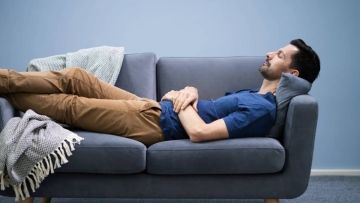
One of the fondest childhood memories many share is dozing off on the couch while watching a favorite TV show, only to wake up in bed as if transported there magically—thanks to our parents.
As we grow older, the scenario changes slightly. We might still fall asleep on the couch, but we often drag ourselves to bed only to find that the drowsiness disappears. What’s behind this puzzling phenomenon?
Falling asleep on the couch is a common experience, often linked to the body’s natural sleep drive, known as sleep pressure.
Dr. Manjunath, a pulmonology consultant at Gleneagles BGS Hospital in Bangalore, explains:
“Sleep pressure builds up throughout the day. When you relax on the couch in a comfortable, semi-alert state, it creates the perfect scenario for your brain to give in to rest.”
This pressure is influenced by the accumulation of adenosine, a neurotransmitter that promotes sleep. Even brief moments of relaxation can trigger a quick response to rest, especially when mentally unwinding.
The relaxed posture of the couch also sends signals to the brain to let its guard down, reducing alertness and encouraging sleep. Subtle background noises, such as the low hum of the TV, act as white noise, enhancing the couch's appeal for a quick nap.
Why Beds Feel Different
According to Dr. Satyanarayana Mysore, head of pulmonology at Manipal Hospital, environmental factors play a key role in initiating and maintaining sleep. The temperature of your surroundings, for instance, significantly impacts sleep quality: warmer temperatures may shorten sleep cycles, while cooler settings extend them.
Couches often offer a less structured, more casual environment that removes the pressure of “trying” to fall asleep. Beds, in contrast, can evoke a psychological expectation to sleep, making it harder to achieve the same relaxed state.
The Role of Circadian Rhythms
Your body’s internal clock, or circadian rhythm, dictates your sleep-wake cycle. Dr. Manjunath notes:
“If you’re lying on the couch during a natural dip in wakefulness, such as early afternoon or late evening, your body interprets it as an ideal time to rest.”
As evening progresses, melatonin levels increase, promoting drowsiness. Coupled with the right atmosphere, the couch can become an irresistible spot for sleep.
However, moving to the bed can interrupt this relaxed state. The act of transitioning can briefly heighten alertness, resetting your sleep pressure and making it harder to fall back asleep. Uncomfortable bedding, noise, or light disturbances further exacerbate the issue.
Aging and Sleep Patterns
With age, sleep habits and needs evolve. Insufficient nighttime rest, due to insomnia or sleep apnea, might lead older adults to nap unintentionally—often on the couch.
Dr. Manjunath highlights: “Older individuals are more prone to unintentional naps, including on couches, due to changes in sleep structure and accumulated sleep pressure.”
Breaking the Cycle
If you find it harder to sleep in bed after napping on the couch, consider optimizing your bedroom environment. Comfortable mattresses, proper pillows, and minimizing light and noise can improve the transition. Maintaining regular sleep schedules and avoiding caffeine late in the day also help.
Ultimately, the ease of couch-sleep versus bed-sleep boils down to intent. On the couch, you’re not actively trying to sleep, allowing your body to relax naturally. In bed, the mental focus on falling asleep can create a barrier, turning what should be a restful activity into a challenge.